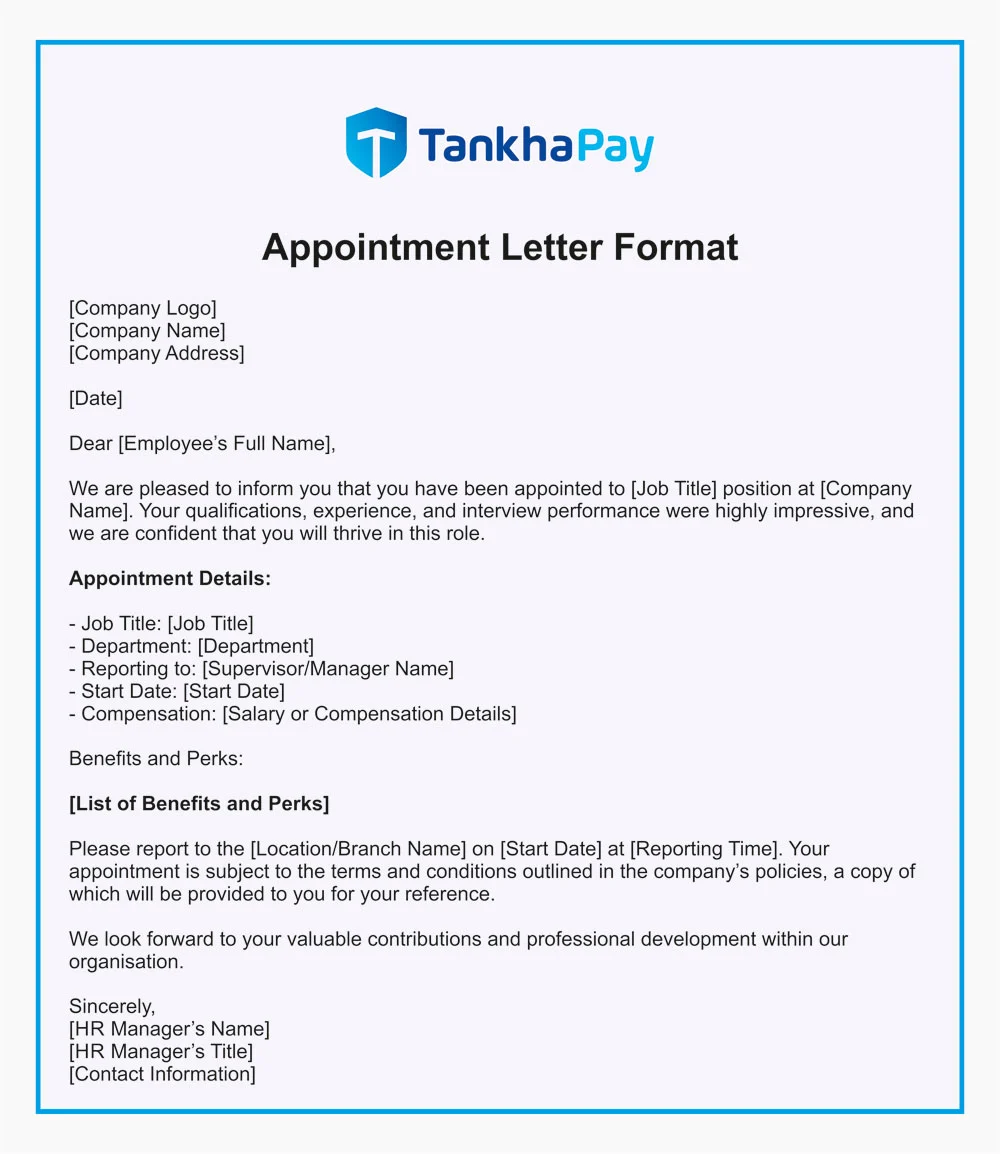Introduction to an Appointment Letter
It is a formal document issued by the employer to a selected candidate where employment with the company is confirmed. This is a formal, legally binding document, which makes the job role, responsibilities, salary, and other terms of employment official in a contract form between the employer and the employee. An appointment letter is, in fact different from an offer letter, because it is the formal, primary, and decisive contract between an employer and his or her new employee.
An appointment letter, if well-structured, provides clarity and transparency that helps both parties understand their rights and liabilities properly. It plays a prime role in avoiding misunderstandings and legal disputes in the workplace.
Important elements of an Appointment Letter
An appointment letter format drafted with proper care includes crucial elements to avoid vagueness. Here is the list of key elements.
Employee's details - Full name, address, designation, and department.
Company Information- Company name, office address and any other official address for contacting purpose.
Joining Date – the date of an employee's joining with an organization.
Designation and job description – detailed account of works to be performed with related authorities
Compensation and Benefits –dedicated amount and types of bonus apart from fringe benefits
Probation Period- Probation period along with the set criteria of appraisals.
Workplace and Working Hours –Details about workplace and working hours
Leave Policy - Paid leaves, sick leaves, holidays etc.,
Termination and Notice Period-When the job can be stopped by any side
Confidentiality and Non-Compete Clause -No disclosure about information related to a company or employed at competitors firm.
There is given an appointment letter format in both Word and PDF forms so that consistency is maintained in every single job position in the organization.
Legal Significance of an Appointment Letter
An appointment letter itself is not a letter but may have very important significance in legal terms regarding the employment contract. Some of the legal implications can be as follows:
Evidence of employment: Official document to prove evidence that the person is an employee of the company.
It can be used in court cases concerning labor disputes, wrongful termination, or breach of contract.
Protection of Employee Rights: The appointment letter ensures the employee receives salary, benefits, and job security as stated in the contract.
Employer Liability: If the employer fails to perform the conditions specified in the appointment letter, the employer is liable legally.
A well-composed appointment letter safeguards both the employer and the employee from likely violations of labor laws and regulations.
Duties of Employer in Issuance of Appointment Letter
Every employer should issue a validly documented appointment letter. The duties are:
Issue the Letter in Time – The appointment letter must be issued either on or before the date of joining by the employee.
Terms and Conditions Must be Clear – To avoid vague terms, thus clear.
Compliance with Labor Law – The appointment letter should be as per the employment law of the country.
Retain the Signed Copies – The employers should retain a signed copy for further use.
Answering the Queries of Employees-The employer should not dodge the question of the employee and must clearly express the terms and conditions before affixing his signature on the letter.
Even an employer can be dragged to court and penalized with a heavy fine if an appointment letter is not issued or its terms and conditions are misleading and false.
Rights of Employee and Inclusions with Appointment Letter
Many rights and protection of employees are offered by an appointment letter. A few of those are as follows:
Job Security – The term covered in this letter ensures that no worker is removed or sacked without proper procedure.
Purse and other benefits – That assures employees receive their promised purse and other incentives.
Protection against Exploitation – Proper definition of working hours and work will prevent overburdening the worker.
Redresses in law court – If the employee breaches the contract, employees seek redress for the case that they file through the court.
Employees have the right of no appointing letter if they fall under a workplace difference.
Common Error in Appointment letters & How Avoid Them
Employees and employers commit some major mistakes while preparing the appointment letters that creates a ripple effect among others. Most common mistakes with the appointment letter and how not to do are as follows.
1. Vague Job Description
Error: It contains vague job description and responsibility.
Solution: It has clear job expectation and performance standards.
2. Inadequate Compensation Details
Error: It doesn't mention break-up of the salary and benefits.
Solution: It should be explicitly stated as base salary, bonuses, deductions, and other fringe benefits.
3. Notice Period Clause not mentioned
Error: The terms of resignation and termination are not clear.
Solution: The period of notice period and the terms of it should be clearly indicated.
4. Violation of Labor Laws
Error: The letter is not prepared according to the labor laws.
Solution: Accept the professional advice from legal experts for formulating the employment agreement following employment rules.
The meaning of above statement is the employment contract should be legal or non-dispute one.
Letter of Appointment with respect to settlement of employer / employee disputes
The letter of appointment can prove as evidence to resolve disputes, between employers or employees in dispute regarding the above:
Unjust Termination – This can be based on many issues. The workers assert that their employees were being unjustly terminated.
Salary and Benefits Discrepancies – Ensures the employees get what was agreed upon.
Workplace Misbehaviour Complaints – It specifies the expected conduct and the actions of punishments.
Promotion and Promotion Increment Disputes – It acts as proof for acceptance in promotions or increments.
Accurate record as an appointment letter sample helps both the employees and the employers attain mutual consent in case disputes arise.
Appointment Letter Templates and Letterheads
Appointment letters are designed according to the various professions and their regulations in a respective company. Some of the appointment letters are as follows.
1. General Appointment Letter
Where full-time employment job, then it includes every term and condition by the side of the employer.
2. Short term Appointment letter
Issued under short-term services or project basis
3. Internship Appointment Letter
It is furnished to the trainees, whereby it makes terms of internship and stipend expectations.
4. Probationary Appointment Letter
It is also issued to probationers wherein some terms and condition have been agreed for confirmation in the service of an organization.
This saving in time and effort of standardizing and personalizing appointment letters comes about due to using a word appointment letter template by an HR professional.
What If An Employee Does Not Get an Appointment Letter?
When an employer fails to issue an appointment letter, the following issues face the employee:
Un certainty about the employment terms
Issues in proving the job status
Issues in salary and benefit claims
Legal risk if disputes arise
Employees should ask for the appointment letter in writing and present the issue to HR or labor authorities, if need be.
Conclusion: Why Every Employee Should Have an Appointment Letter
An appointment letter is a very important document that clearly states the terms of employment, so it becomes clear, trustworthy, and protected by law for the employees and their employers. Such a letter makes all threats of misunderstandings, disputes, and exploitation disappear at work.
The appointment letter by the employer must be clear, legally compliant, and detailed. Employees are supposed to read and analyze the appointment letter before they affix their signature on it. An organized appointment letter is the foundation for a well-organized working relationship.

















